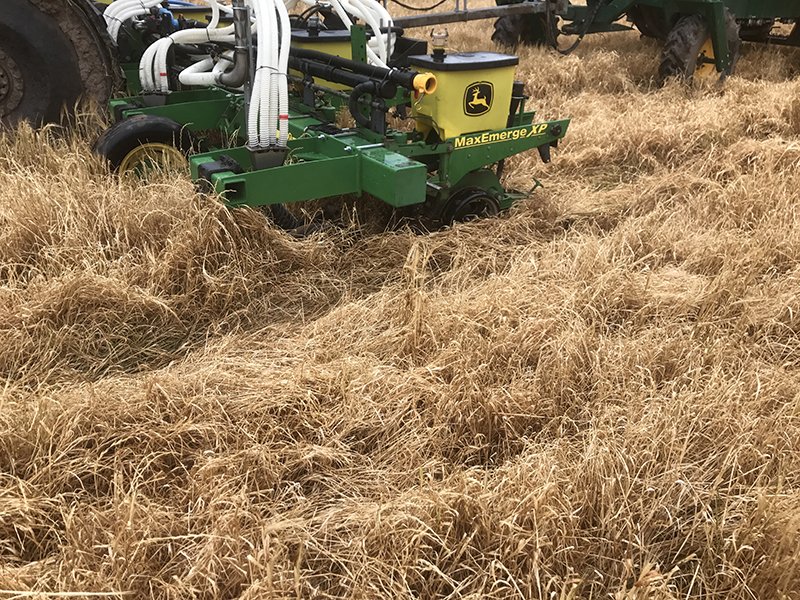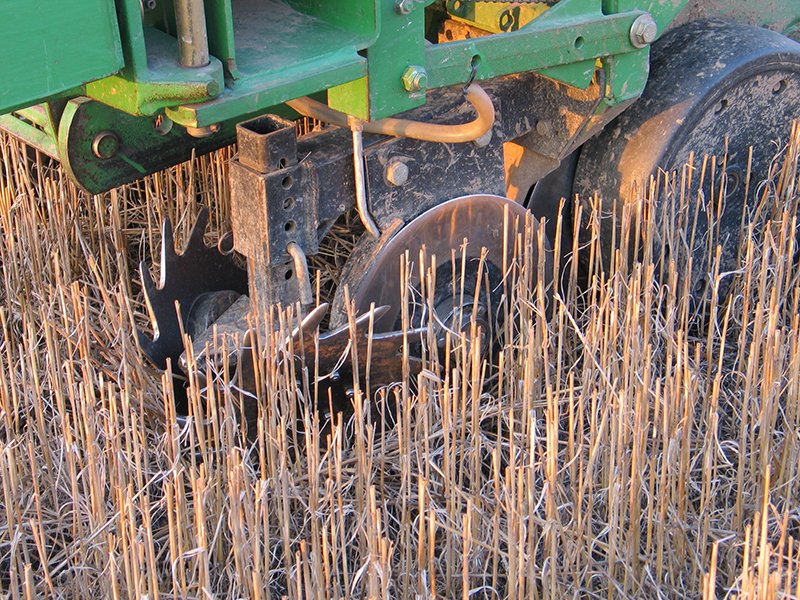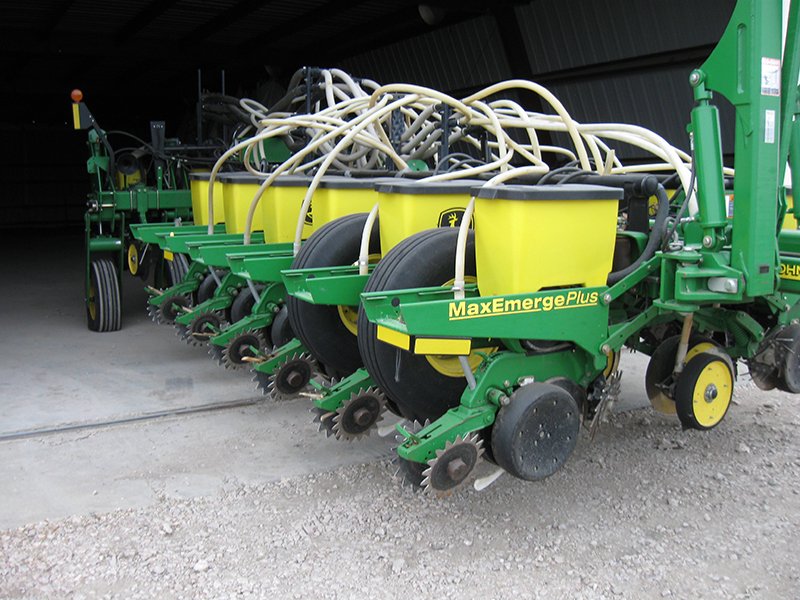by Matt Hagny,
freelance agronomic consultant for no-till since ’94;
founder & president of Exapta Solutions since ’99.
Several companies offer a fertilizer opener that mounts directly to the front of the planter row unit, usually in combination with a row cleaner: the Martin UMO (“Unit-Mounted Opener”), for instance. Sunco has one. So does Dawn. There are others.
Sunco fertilizer opener mounted to planter row unit.
There are problems with these. First, they rob downforce from the row unit, and many planters don’t have any to spare! Maintaining seed depth is much more important than putting fertilizer into the soil (which can be done a number of ways besides running something thru the soil that’s hanging on the planter). Risk of not being able to get all the seeds to the proper depth is alone a good reason for most no-tillers to avoid side-band openers, except in the mellowest of soils (Great Lakes region of US/Canada), and even then there’s a risk if you hit a dry year at planting and need the extra downforce to maintain seed depth.
Second, these unit-mounted openers usually cannot be moved far enough away from where the seed row will be to prevent seed placement issues. I’ve found that anytime a side-band opener is closer to the row than four inches in long-term no-till, it causes problems from loosening the soil and creating more sidewall collapse/blowout, more voids for seeds to get into, and difficulty controlling the closing action on that side of the furrow. Even at four inches away, the opener will cause too much loosening if it runs more than two inches deep (it takes severe down-pressure to go deeper than that anyway), and since the nodal (crown) roots of corn start out about one inch below the soil surface and grow horizontal or even upward in moist no-till soils, it makes no agronomic sense to place fertilizer deeper than one-and-a-half inches except possibly in the very driest regions.
And in tough soils, running a side-band opener at all (even four inches away, and shallow) causes premature bearing failure on the seed opener blades on JD/Kinze/AGCO openers because of uneven loading (soil is loosened on one side but not the other). Many farmers, including Dietrich Kastens (discussed later), gave up on side-band openers long ago simply for this reason.
Third, they create problems with residue flow. You may get along okay most of the time, but in tough conditions, they plug. The Suncos might not plug quite as frequently as the Martin UMO, but there’s still issues, especially in stripper-harvested small grain stubble. (This probably isn’t a big concern if all you plant into is soybean stubble, so long as it’s evenly spread and not ropey.)
Fourth, they add vibration to the metering mechanism. Fifth, they add side-load to the parallel link, hastening the wear on the bushings and holes.
I’m not a big fan of side-band fertilizer openers, but if you choose to use them at all, you’re much better off having them mounted directly to the toolbar. It took me a long time to reach this conclusion, but my view is that many geographies cannot afford the destruction of mulch cover from running separate fertilizer openers thru the soil, nor is it really necessary since there are many good ways of applying N on the surface and letting precipitation (or irrigation) move it into the soil. There are other costs, direct and indirect, of running separate fertilizer openers, including planting more weed seeds, owning more equipment and keeping it running, slowing down the seeding operation, causing more compaction, making the planter too heavy and getting stuck, etc.
At least these side-band openers are mounted to the frame (much better than mounted to the row unit). These in the photo have a modified boot to accept dry fertilizer delivery from an air cart towed behind the planter. If you’re going to run sideband fertilizer openers, regardless of style, make sure they’re at least 4 – 5″ away from the seed row, and run no deeper than 2″, lest you adversely affect seed placement with JD/Kinze/Agco-White type of openers in no-till.
When the first few no-tillers started out in Kansas 20+ yrs ago, we set up all the planters with side-band openers because that’s what Dwayne Beck taught. One by one, nearly all of these no-tillers ended up abandoning side-band openers for one reason or another (some still stream part or all of their N on behind the closing wheels, however)—often due to cost, maintenance, residue flow, or erosion problems. So, it’s not like I’ve always had a bias against side-band fertilizer openers. But as our erosion problems and lack of mulch persisted, I became convinced that running extra openers just to put highly mobile nutrients into the soil was penny-wise and pound-foolish: We needed to preserve every speck of mulch we could. Although my conclusion pertains to central and western Kansas (& Oklahoma & Nebraska) in particular and may not be applicable in far eastern KS counties or the northern Corn Belt.

Now, for the opposing viewpoint, some agronomists such as Andy Holzwarth who works in eastern KS contend that they simply can’t get top corn yields consistently in their wet claypan soils unless they put the N fertilizer uniformly into the ground and close to the row. He has observed significant volatilization and N runoff after surface N applications on wet soils. Oftentimes after applying N on saturated soils and then getting a downpour the N can’t move downward, and it runs off (N runoff is quite visible by excessive greenup of brome waterways). Additionally, in saturated soils, the plant roots don’t spread and grow vigorously until it dries out and oxygen is available. In this situation, N placement close to the row helps ensure an ample supply of N to fast-growing corn plants even though the roots are growing slowly. K-State research in eastern Kansas partially supports this conclusion, even though most of their research is done on silt loams with far fewer problems than claypans that Holzwarth is describing.
I will take the counterpoint that if you have runoff after planting, that’s a great reason to not have run extra openers just to apply fertilizer—that just causes even more soil erosion. Or better yet, solve both the runoff and excessively wet, poorly aerated condition by growing a broadleaf cover-crop over winter and not kill it until after corn planting. I realize this adds management issues, but it’s really what needs to be done in this region. This said, if all you farm is perfectly level fields, and can get over the acres in a timely manner, side-band openers might be the best choice for you.
Ray Ward is certainly an expert on the matter, and he also is rather insistent that N fertilizers be placed in the soil. However, John Grove—with credentials and practical experience as extensive as Ray—isn’t nearly as concerned so long as we mind the details (timing, and using NBPT/Agrotain in high-risk situations). So if these experts cannot agree, my default is to do what is least damaging to the soil—the practice that causes the least compaction and the least erosion potential is to avoid running those extra openers just to place fertilizer.
I don’t doubt for a second that we give up (on average) 5 – 10% of our N efficiency by surface application, but the costs (direct and indirect) of subsurface placement are often too much to justify it (especially at lower use rates for lower yield goals in the drought-prone areas of central/western KS). In a perfect world, we’d have some way of placing it subsurface without causing so much collateral damage, cost, and inconvenience—but much of farming isn’t in this perfect world. When it’s all factored in, it’s often wisest to simply apply the N (and S and K) on the soil surface, perhaps using Agrotain when conditions justify. Many of the most advanced, largest no-tillers have gone this direction since it’s just not realistic to apply lots of product at planting. Dietrich, Terry & Gary Kastens, in managing a very large grain farm in far northwest KS under long-term no-till, were once very convinced that subsurface was the right answer. But they too switched to broadcasting years ago and aren’t looking back with regrets.
Terry Kastens explains their 2017 experience:
“I know that no one likes to plant in wet conditions, but sometimes you have to. This spring our area was quite wet, with occasional rains and many foggy/drizzly days — far from ideal conditions on lands that mostly contain contoured terraces. Most guys around here use [sideband] openers with liquid fertilizer. Many had to start planting later in the year than did we, had fewer days they could plant once rolling, and got less done per day due to plugging issues. Consequently, many of these guys had to a) move to shorter-season corn, b) switch to an alternative crop (typically milo), or c) abandon the idea of planting in the spring at all, switching instead to wheat this fall. [None of these options were good financially.] Meanwhile, due to all of the extra rain, we were able to make a last-minute decision to even increase our planted acres over what we had intended. Note that the problem with openers this spring was complicated by the extra slippage of tractor tires due to pulling a fertilizer cart behind the planter — not to mention the lost time filling and hauling fertilizer, etc. So, this spring helped confirm our decision to abandon liquid fertilizer [sideband] with the planter.”
You might be wondering about how to apply P, which is less mobile. But not immobile. U. Neb data from Paul Jasa show that surface- or shallow-applied P fertilizers move down thru the soil profile at the rate of about 0.75″ per year in low-disturbance no-till. Other studies and observations support this, except where soil pH is very high. So, in high-rainfall areas, surface-applied P is generally just fine agronomically (a large body of evidence supports this conclusion), unless your soil test levels are extremely low. Environmentally, surface-applied P isn’t so nice if you have any runoff, however—but putting it out onto a vigorous cover crop in long-term no-till will eliminate almost all runoff. Same goes if you have nightcrawlers (vertical burrows), which again eliminate nearly all runoff in places such as Kentucky under long-term no-till.
Now, I’d still run pop-up fertilizer containing N & P & certain micros, unless you’re always planting in very warm, high-fertility soils—see my newsletter on pop-up practices, methods, products. Since it’s a relatively small amount of P that can be safely applied as pop-up (even though it’s tremendously beneficial, and the most efficient fertilizer you’ll ever apply), most areas with moderate to high yields will need additional P application unless you’re applying a lot of manure or poultry litter. If there’s small grain in the rotation, even just as a cover crop, seeding them with grain drills is a great way to apply hefty rates of P because the narrow spacing and relatively high tolerance that small grains have to appropriate pop-up fertilizers. Because most of the drier regions have wheat in the rotation, simply applying extra P for the wheat will help provide for subsequent corn crops (and wheat is more responsive to P than corn anyway). Higher rainfall areas can rely on rain to move surface-applied P into the soil or apply P fertilizer as pop-up when drilling cereal rye for cover crop. And, we’re finding with long-term no-till with high diversity of species grown, that we can get by with dramatically lower levels of P in the soil anyway—so you might find you don’t need to be pouring so much out there to get the same yields as you did when you were still doing tillage and/or low-diversity rotations without cover crops.
All this being said, it is extremely important to supply adequate nutrients so that they’re in the proper location for root uptake by the time the crop needs them! (But not so early they leach away or denitrify.) Some people seriously underestimate just how much N & S the crop needs early in its life, especially in cool soils with slow mineralization of OM.
For a bit more on how to set upside-band openers to be the least problematic, and whether to run fertilizer at all on planters, see our DVDs: No-Till Seeding Explained, and 2016-2017 Seeding School video footage. How and when to apply N fertilizers, which to use, and which stabilizers are actually effective (some are snake oil) is also a topic that John Grove and I have covered extensively at my Crop Health Workshops.


